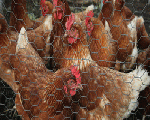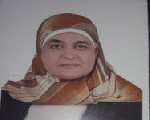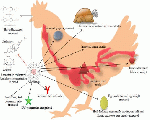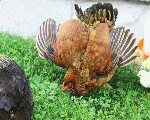Some common diseases in poultry

2023-08-30 11:38:46
Some common diseases in poultry common diseases in poultry can be divided into the following: first: viral diseases: 1-Maric Maric disease is an immunosuppressive malignant cancerous viral disease that affects poultry starting from the age of 6 weeks, but it usually spreads in adult chickens between 12-24 weeks and the incubation period of the disease is about 6 weeks and the disease is highly infectious epidemic, where the death rate in unvaccinated herds reaches about 10-30% and may sometimes reach 80% . Symptoms: the symptoms of the disease appear in the form of slow growth with paralysis of the legs and wings, where the bird walks in an abnormal way, and then loses control of its legs, in which lameness occurs, then the man's fingers twist with the curvature of the knee joint and atrophy of the thigh muscles with the appearance of yellowish watery diarrhea with an unpleasant odor with the inability of the bird to move to radiation and deformation of the iris, its ability to respond to light decreases and gradually narrows, and the bird may become blind. Ways of infection : The disease is contracted to young chicks during the first weeks of life by the virus present in the dust and brush of amber as a result of infection of a previous herd bred with it and not disinfected, as the infection spreads through the respiratory tract and in several days the virus spreads in the lymphoid tissues causing the tumor and within two weeks the virus spreads in the roots and cavities of the feathers, as coccidiosis and internal parasites prepare the bird for contact with the chick has been infected with the virus since the first day of its life, but it remains alive in the bird's body for the entire period of its life, despite the presence of objects Immunity in his body is caused by immunization or by transmission from the mother, but the virus does not show any activity until a few weeks later because the multiplication of the virus is slow and its incubation period is long . Prevention and treatment: 1-breeding breeds of birds that have a high genetic ability to resist the disease. 2-pay attention to ventilation and disinfection of wards with formalin 3% or caustic soda 1% because they can eliminate the virus immediately and not raise different ages of chicks in the same farm and also not fluctuate temperatures by rising and falling, which causes birds colds with other stressful factors such as lack of nutrition, crowding or poor ventilation, leading to high mortality and not benefiting from the vaccine used . 3-immunization against the disease with the Marik vaccine by dissolving the vaccine in the solvent solution supplied with it and injecting at a rate of 0.2 cm/ chick into the thigh muscle or under the skin of the neck, directly upon hatching. 2-Newcastle Newcastle is one of the rapidly spreading epidemic viral diseases that cause huge losses to breeders, and it is one of the most important diseases that breeders warn about in Egypt, as this virus has the ability to infect the herd to 100% as well as the death rate to 100%. The virus has the ability to infect chickens and turkeys, as they are the most susceptible species to this disease, and both pigeons, ducks and geese are infected with the disease, but to a lesser extent, and when a person is exposed to the Newcastle virus, he shows signs of eye disease, which is called ( red eye), and this phenomenon spreads among workers working on farms infected with this disease. The virus has a high ability to keep its life for three months alive in the carcasses of infected birds and stored in the refrigerator at zero degrees Celsius, but the opposite happens when the temperature is raised, as it cannot live for more than a few minutes if exposed to a temperature of 50 m.it was also found that some disinfectants such as formalin and phenol have the ability to lose the virus's vitality and kill it.The incubation period of the disease ranges from 2 to 18 days, depending on the virulence of the virus. Symptoms : Symptoms appear on the bird at first as respiratory symptoms, as the Bird opens its mouth with its neck extended to get as much air as possible, which leads to hearing rattling sounds as a result of air entering the trachea, and this condition increases at night, followed by diarrhea of the bird, which is green mixed with white lime secretions, and the color of the custom and rattles turns dark red or blue with indigestion and the after that, neurological symptoms such as violent trembling, paralysis of the limbs, bending the neck up or down, imbalance and flying occur In the air and then fall to the ground hard and then the bird dies. In the case of adult birds, there is a clear decrease in egg production ranging from 20-50% and may stop completely with the production of eggs without a shell (Brecht) or the shell is weak and fragile . Prevention and treatment : to prevent Newcastle disease, the following must be followed: o immunization against the disease with the appropriate vaccine at the appropriate times is the most important measures to protect against the disease and there are many live and dead vaccines and the hechner B1 and lassota vaccines are one of the most important vaccines used in Egypt, by spraying, dipping or in drinking water, as well as the use of bad environmental conditions such as extreme cold or heat, which affect the vitality of the herd. As well as providing complete nutritional relationships balanced in their content of nutrients, as the imbalance of relationships and the lack of their quantities lead to reducing the resistance of the bird. Poor ventilation also leads to increased humidity and an increase in ammonia gas, which causes respiratory diseases that predispose the herd to infection. 3. Observing the sanitary conditions on the farm, such as carrying out disinfection programs with all accuracy and care while preventing outsiders from entering the farm, and working on a rodent, dog and cat control program, as they are one of the factors helping to transfer the disease from one farm to another with the execution of dead birds, burning and burying them and not throwing them in the open .
Read more about fungal poultry diseases and ways to address them
الموضوعات المشابهه

The poultry industry between the challenges of

Diseases (infectious Bursa diseases)

The role of chromium in the health

Your guide to veterinary medicines

Tips for broiler breeders to deal with

The use of dietary nucleotides in poultry

Agriculture receives an official delegation from the

Some common diseases in poultry

26 cattle and 1400 chickens died in

The role of chromium in poultry nutrition

The minister of Agriculture announces the release

Body language in chickens

Comments
Add comment